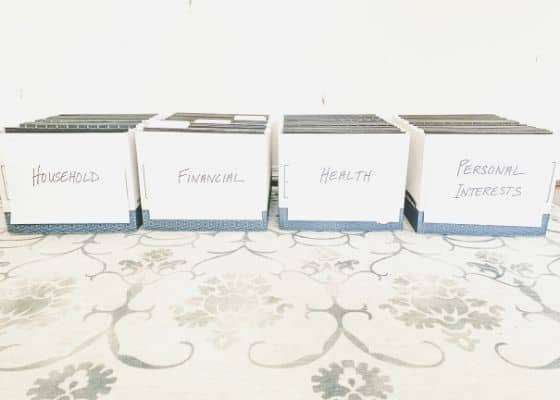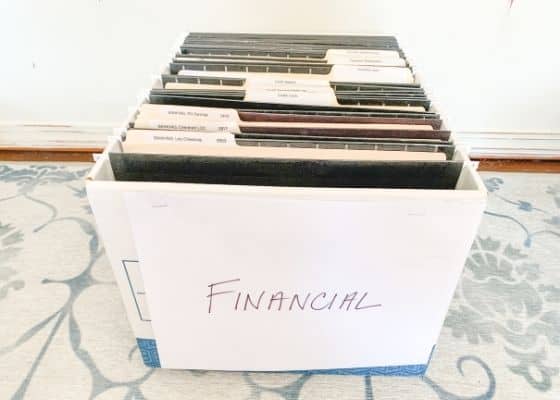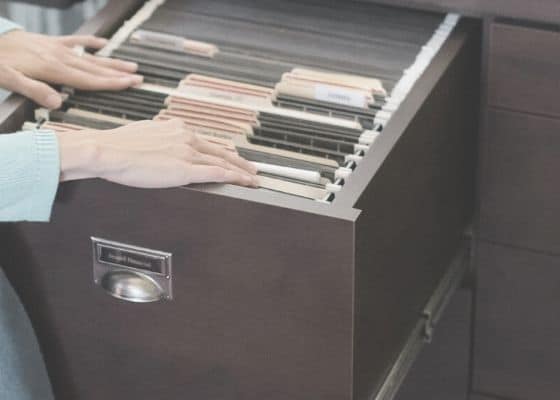IGEL Blog

Turning Piles into Files
Nearly all of us have a robust electronic life in this information age, but many of us ALSO have a huge backlog of PAPER! If you can relate to piles on every surface, or an overstuffed filing cabinet into which you can’t stuff another thing, you’ll get inspiration and practical help from this filing tutorial!
Whether we are buried under old paper from our hard copy days or new documents that keep coming in, we need a strategy for identifying and keeping the important stuff.
If you’re like me, you love the PRINT BUTTON. I confess: I’m a hard copy girl. I’ll opt for a print copy over an electronic copy when I’m reading something. I like to highlight, use my clicker pen, and write on documents. Something about the kinesthetic touchability of paper works for my brain. But I do realize that this penchant for paper causes pile-up of documents.
Over the recent years, I’ve thinned out the volume of my files as they have “aged out.” But, for me, a business owner and administrator, certain essential permanent paper is here to stay. I don’t plan on scanning key reference documents like medical records and financial paperwork. That means a good, simple, and expandable filing system is needed.
If you’re like me, and you like the comfort of records-at-your-fingertips, you, too, need a reliable filing system.
In this blog, I’m going to help you tame those piles; the permanent paper that you need to keep.
Ingather All Paper & Files

The first step is to ingather all files and paperwork.
Most people have multiple files and piles stashed all over the house. I want you to ingather them from everywhere. It could be in innumerable locations:
- Stagnating on your desk
- Dumped on the floor of your home office
- Packed into your file cabinet(s)
- Landed on the kitchen counter
- Taking up territory on the dining table
- Stashed in boxes in the garage
- Piled up on your nightstand or dresser
- Laying on the couch
This list makes me chuckle because it’s all-too-real! Can you tell I’ve been working with paper lovers as a career?
Paper has a way of traveling throughout the home. It likes to “land” and “set up camp” on surfaces, crowding out usable space.
In your ingathering process, you are corralling all this paper into ONE room and ONE sort. You’re trying to ensure that no-paper-is-left-behind!
(The only exception to your permanent paper file sort is ARCHIVAL PAPER – like past tax year’s supporting documentation or family memorabilia.)
What you’re looking for is PERMANENT paper. Paper that should be filed is completed; it’s done, it no longer requires action and it now serves as REFERENCE. You’ve determined that you, in fact, need it and that accessing the same information online or through an institution is either not possible or convenient.
Because you’re ingathering only permanent paper into your file sort, you are NOT looking for:
- Quick-turn over, hot actionable paper
- Short-term, active projects that you’re working on now
Each of these two other types of paper require their own unique systems. If you struggle with incoming, hot paper, see my blog “How to Process Paper – Tackling Your To Dos & Tasks with an Action Center.” If you need a hand with projects, read my blog “Handling Projects: Action Files for Managing Pending Work.”
Most people have stuffed file cabinets plus a ton of permanent paper that really should be filed, spread out all over the place. Ingathering all this completed paper into one sort is critical to creating a complete, organized system so the “paper creep” won’t come back!
Categorize
As you’re ingathering, you’re not just going to haul the piles and boxes into one room. You’re going to macro-sort, or categorize your paper into like-item groups. You’re taking the time to touch it; so you might as well limit the times you have to deal with that old, completed paper.

Set up a 4-6 banker’s boxes and add hanging folders to each. Common household filing systems include the following categories:
- Household
- Financial
- Medical/Health
- Personal Interests
- Professional (if you have kept a lot of old resumes, work samples, career info)
Drop ingathered paperwork into one of the categorized boxes right into a hanging file folder (if it is already in a file). If it’s a loose paper, affix a temporary sticky note label onto the file label section on a manila file folder to identify that paper that you’ve found (ie: Health Insurance Plan”).
You can employ old, used file folders for this sorting process if you like – don’t worry about the color or condition of the file; you’re simply identifying the paper at this stage.
I call this phase of macro-sorting into categories “bucketizing,” because you are simply trying to get each paper or file into the correct “bucket.” You’re not worried about whether you need the paper, whether it’s outdated, or even the perfect file name. You’re only concentrating on routing each item into the correct category.
In addition to using hanging files, I like using 1/3 cut file folders, which allow enough space for a useful label. Once you’ve correctly identified the file with a good name, you can drop that file into a hanging file folder. I like using one file folder per hanging file; this allows plenty of room to move the hanging files around.
Here are a few essential categorizing tips to keep in mind:
- Don’t set up more than 6 category boxes; avoid over-creating. Simple is best.
- Assign a color to each category (ie: Medical= red; Financial: green, etc.) for easy reference. (You won’t employ these colored files until you are completely done with categorizing and sub-categorizing and making your permanent files.)
Sub-Categorize
After you’ve got all paper in the right bucket, or category, then you can subcategorize.

This is your micro-sort phase wherein you are whittling down the larger category into sub-categories.
Sub-categorizing your files allows you to create subdivisions within each major category to break it down a bit.
For example, in your Financial category, our professional organizers usually find the following sub-categories:
- Banking
- Credit
- Expenses
- Investments
- Insurance
- Taxes
By subdividing each category further, you will make the category SO much easier to navigate. Categorizing and sub-categorizing is a deductive system. This system allows you to determine a file’s appropriate “bucket,” and then peer into that category, find the appropriate subcategory, and then file appropriately. A sub-categorized file drawer also makes retrieval easier when you want to locate a file.
Each major category can be sub-categorized into various smaller “neighborhoods,” as above. Thus, the category is the city, and the sub-categories are the neighborhoods.
After you get all files and loose paperwork into a category, move the files around in the banker’s box, grouping like-items together. Then, label each subcategory with an upside-down sticky note denoting its subcategory (like “Banking”).
Now that you have each category subcategorized, it’s time to thin out your paperwork, not before. Once you can see all similar paperwork together, it’s pretty easy to “prune” out old, unnecessary paperwork, remembering that the majority of what we keep we never look at again.
If you try to thin out your paperwork before you can see it all together, you will derail the process with too much decision-making. (It’s kind of like closet organizing: get all your t-shirts together before you force yourself to decide which to donate!)
Beware of several filing mistakes people make at this sub-categorizing stage:
- After getting paper into one general category, they give up, leaving a messy category that is still hard to navigate.
- They try to alphabetize each category’s individual files instead of sub-categorizing. This makes it difficult to find paperwork in the future, because an alphabetical system relies on what the user was thinking the moment they filed it. Simple sub-categories within a greater category makes more sense and is an easier, deductive system.
- They label files individually rather than as a part of a subcategory. Unfortunately, this way each file is independent, instead of belonging to a neat little subdivision.

Now that your files are subcategorized and unnecessary, old paperwork is removed, you can formalize these neighborhoods by assigning a tab position (left, center, right) to each subcategory. For example, your Banking subcategory might be denoted by using all left tab position file folders:
- Banking: Business Checking
- Banking: Personal Checking
- Banking: Personal Savings
Your Credit files might then be in the center tab position. Then, your Expenses files might be in the right tab position. In this way, each subcategory is alphabetically assigned a tab position to set off each “neighborhood” of related files.
If you don’t want to use colored file folders, using a color strip label (as in the above picture) on the file folder label is another way to identify the broader category. All your health files might be red, and the subcategories would be indicated by tab position (as above.)
The subcategorizing phase is critical to the filing process. It forces you to really think about the content of each category BEFORE you file it. But this mental work upfront will pay off in easy retrieval later. Without subcategorizing, you’ve made your permanent paper only somewhat easier to find. You can get to the right drawer, but finding the individual file is still a mystery. When you subcategorize, you make identification and retrieval a breeze.
Finalize your subcategories with matching labels. I like to denote BOTH the subcategory name AND the file name in a label. Example: Health Records: Vicki; Health Records: Trevor, etc.
Clear, consistent labels following a naming convention makes file identification easy and easy-on-the-eye.
Filing Tips
Filing has got to be one of the most intimidating of all organizing projects. People delay and resist learning how to file precisely because it is complex. I hope I’ve eliminated the intimidation that can come with the filing project in front of you with these simple macro and micro steps.
The biggest obstacle to filing is categorizing, but hopefully you now feel confident in “bucketizing.”
Once you’ve categorized, sub-categorizing is simply creating mini-buckets within the bigger bucket.
Be sure to set aside enough time to complete the filing project. As a professional organizer, I’ve found that most of my file projects take between 10-16 hours if there are a lot of files. I’ve completed a file system in as little as 4 hours, and I have taken on some epic file systems taking upwards of 24 hours. The time you should dedicate depends on the volume of files you have.
Don’t forget to create a separate filing system for business and personal. In this blog, I’ve covered your personal files, since we all have personal paperwork. Use this same process to macro and micro sort your business paperwork as well. As you add each file to a box, label the macro category on the front of the box. Let your business categories emerge as you discover the kinds of files you have on hadn.
Common professional categories include: Administration, Corporate, Financial, Legal, Marketing, Operations, Professional Development, Sales, and more! Your business categories will be as unique as your business. Some businesses don’t even have many paper records even more.
An orderly filing system puts you in control of your personal and professional life. Going through the filing process is also very clarifying: it helps you to visually “see” your life records in living color. A streamlined file system also puts at your fingertips key records like titles to personal and real property, critical health records, and your financial history – empowering you to be a good steward. This is why I love filing: it “restores order” and puts you back in the driver’s seat of your life!
Here’s to reclaiming your paper and reclaiming your life!
~Vicki Norris


